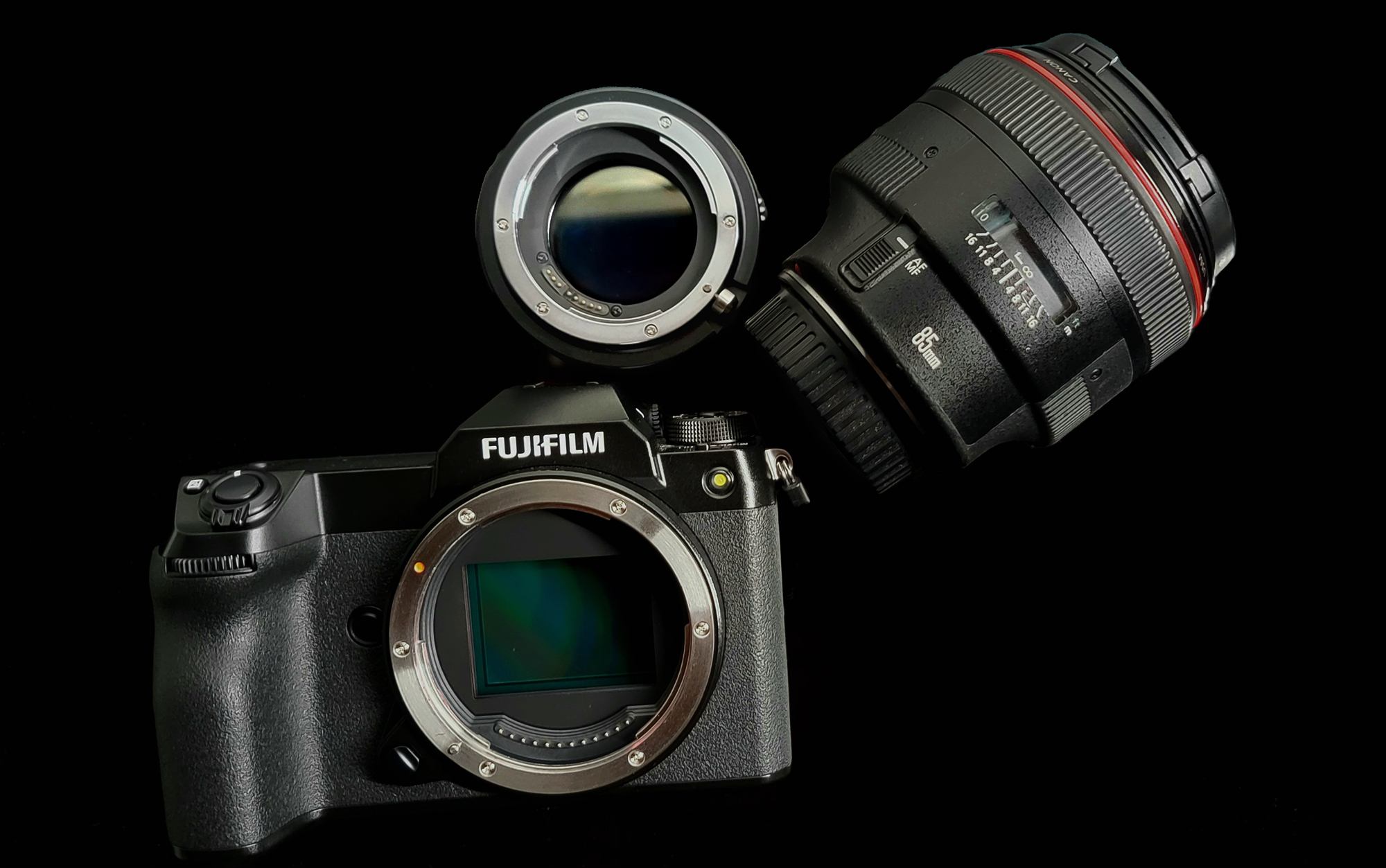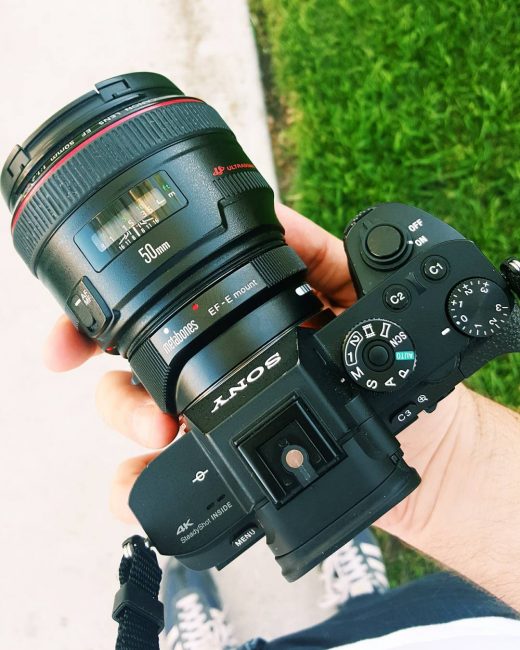Equipment
How Lens Adapters Work & Why You Should Try Them

With both Nikon and Canon switching out their DSLR markets for mirrorless platforms and offering up new lens mounts as a result, and with Sony and Fuji both developing great lenses for their platforms, a common question we get asked is about lens adapters. And lens adapters are no new thing, dating back at least a few decades now; I wasn’t able to get an exact creation date. But as more time goes on, lens adapters have become an increasingly common thing for photographers and videographers alike – so let’s talk about them.
What Are Lens Adapters?
 When you first buy your camera, whether it’s a DSLR or mirrorless camera, you’ll have a lens mount system on the front of it. This mount is designed to easily change lenses on your camera, switching focal length, aperture speed, and much more with a quick button press and turn. These lens mounts are almost exclusively made of metal, and are simple in design, with a few contact pins on them for the camera to communicate with the lens. While these lens mounts can’t really be changed (though it has been done before), but they can be adapted to work with a larger variety of lenses, through the use of a lens adapter.
When you first buy your camera, whether it’s a DSLR or mirrorless camera, you’ll have a lens mount system on the front of it. This mount is designed to easily change lenses on your camera, switching focal length, aperture speed, and much more with a quick button press and turn. These lens mounts are almost exclusively made of metal, and are simple in design, with a few contact pins on them for the camera to communicate with the lens. While these lens mounts can’t really be changed (though it has been done before), but they can be adapted to work with a larger variety of lenses, through the use of a lens adapter.
This means you’re able to convert Canon EF lenses to Sony E-mount cameras, Nikon F-mount lenses to their latest Z series cameras, and in some cases, even change out lenses and cameras that have different sensor sizes, like converting EF mount lenses to work on the Fuji GFX platform. With lens adapters, you’re able to switch camera platforms much easier, and even take some of your grandpa’s old lenses found in a box in the attic for a spin.
How Lens Adapters Work
Fundamentally, the concept of lens adapters is simple. You know those pins and contact plates found on lenses and lens mounts? All a lens mount does is reroute the data sent from those pins and ‘translates’ it so that your camera body reads the information delivered from the lens. This will (usually) allow you to use autofocus, give you correct f-stop readouts, and use the lens as if it was intended for the camera.
Those are electronic adapters, which have become far more popular in recent years that maintain the communication of the lens and camera, and certainly the future of lens adapters – but there are mechanical adapters as well. These adapters are essentially just a metal plate, where you mount your lens to one end, and camera to the other. There is no communication between the two, so your EXIF data will be blank when shooting. You’ll also need lenses that allow you to adjust the aperture manually, in order to maintain the functionality and control of the lens.
SpeedBoosters & Specialty Lens Adapters
However, not all lens adapters are created equal, and some of them offer different features that can add interesting effects to your image quality and lens sharpness. For example, there are lens adapters that can adapt lenses designed for smaller sensors that work on larger sensor platforms, like an adapter that converts Canon EF lenses to an m4/3rd sensor. The reverse is true too, so let’s talk about how these work.

Shot using the Fuji GFX 100s w/ a Canon 85mm f/1.2L II
Adapted using the Vizelex Cine ND Throttle Fusion Smart AF Adapter
How ‘Speed Booster’ Adapters work
When converting a specific lens to a larger sensor size than it was designed for, the term commonly associated with these adapters is called ‘Speed Booster’ adapters, because they end up shortening the focal length, and giving you a larger f-stop. Think of it as the opposite of a teleconverter adapter. A teleconverter will use a convex lens (or magnifying lens) to increase the focal length of a lens by a magnification of 1.4x, 2x, or even 4x. As a result, these lenses will gather less light when shooting, and cause you to lose a stop of light or more – depending on the magnification level. Speed Boosters flip that idea on its head – putting a concave lens between the sensor and lens, offering you a reduced focal length (to better fill the sensor frame), and bringing in more light to the lens – giving you an additional stop of light.

Shot using the Fuji GFX 100s w/ a Canon 85mm f/1.2L II
Adapted using the Vizelex Cine ND Throttle Fusion Smart AF Adapter
The result allows you to drastically expand your lens availability, while also giving you some really unique effects. For example, I recently purchased an adapter that converts Canon EF lenses (designed for a 35mm full-frame camera), onto my Fujifilm GFX medium format camera. Meaning I’m able to use incredibly low aperture lenses like the Canon 85mm f/1.2L II of a medium format – giving me something along the lines of a 66mm f/0.95 lens.

Shot using the Fuji GFX 100s w/ a Canon 85mm f/1.2L II
Adapted using the Vizelex Cine ND Throttle Fusion Smart AF Adapter
Other Speciality Lens Adapters
In addition to teleconverters and speed booster adapters, there are also a few other adapters that will give you specialty properties that your lens or camera mount might not already have. Among the most popular of these adapters are the ones with built-in filters – with variable neutral density filters being the most common. I’ve talked about Neutral Density (ND) filters extensively in the past on this blog, but essentially they limit the amount of light being entered into your lens, allowing you to blur movement, or even help lower your shutter speed so that you can use flashes more effectively on location. Having a filter at the base of the lens (resulting in a much smaller filter) is inherently a more affordable process, as it works as a one size fits all solution, and is smaller than most traditional filters. This is why it’s common to see drop-in filter systems for large telephoto lenses, like the Canon EF 200-400mm f/4L IS USM Extender 1.4x Lens.
Downfalls to Lens Adapters
Obviously, having lens adapters isn’t all good news with none of the bad. With each new element added to the equation, you’re adding more variables for what could go wrong. The biggest shortfall of using lens adapters is that you may see some communication issues with your lens and the camera body. Apertures not changing, autofocusing cutting out, and incorrect data displayed on the camera and EXIF data are all more frequent when using an adapter (though they have gotten much much better in recent years). If you’re using an adapter with a piece of glass in it, you will also suffer image quality issues, but that may be minimal. Lens adapter brands don’t have the team of optic specialists that Canon, Nikon, Sony, and Fuji do, so you’re likely getting a mass-manufactured piece of glass in these adapters – though you’re likely to see more image quality issues at the longer focal lengths.
Additionally, adding a lens adapter to your system is going to add size to your lens kit. While this may be marginal, if you’re using something like the Canon 200mm f/2L with a lens adapter, it will be far more noticeable when using a small 50mm lens. The size change of the system is very much user-dependent, if you’re already bringing a full camera bag of lenses to the event you’re shooting, an adapter or two won’t make that big of a difference to your process – but if you’re using the Fuji X-T3 because you love its small form factor, an added adapter is going to change the dynamics of the camera pretty significantly.

Shot using the Fuji GFX 100s w/ a Canon 85mm f/1.2L II
Adapted using the Vizelex Cine ND Throttle Fusion Smart AF Adapter
In the past, I’ve called lens adapters a transition product – something you might buy to support your new Canon R5, while they develop more lenses for the RF series. However, as time has gone on, lens adapters have become way more robust in design, and offer a lot of features that you might not see on traditional lenses. Do you have some examples of creative photos you’ve taken with the use of an adapter? Share some of your favorites in the comments below.
Author: Zach Sutton
I’m Zach and I’m the editor and a frequent writer here at Lensrentals.com. I’m also a commercial beauty photographer in Los Angeles, CA, and offer educational workshops on photography and lighting all over North America.
-
Cheap And Cheerful
-
Daniel Cutter
-
Franz Graphstill
-
Mikelodeon
-
eggplant
-
Tracy Bosworth Page
-
The_Incomparable_Douche
-
Zach Sutton Photography
-
Tracy Bosworth Page
-
Zach Sutton Photography
-
Tracy Bosworth Page
